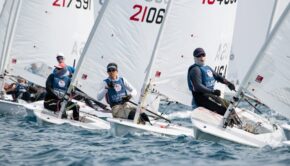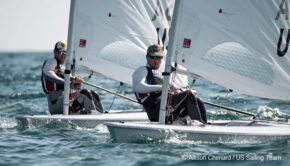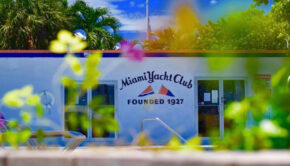Future of Singlehanded Dinghy Racing
Published on October 31st, 2016
Longtime sailor and scribe Kurt Hoehne offers observations on the changing singlehanded dinghy landscape.
Ever since the RS Aero first appeared, everyone seems focused on the question “Which is the better boat, the Aero or the Laser?” As the Melges 14 gains steam, the question will be which is best of the three. However, that’s not the important question. At all.
Both the new boats are surely better than the Laser. They’re 40 years newer and have the advantage of current materials and construction techniques. If they’re not better, RS and Melges have really screwed up. Which they have not. Both companies are clearly committed to making a great product.
No, the real question is, what’s the future of the Laser class? Most of the 210,000 boats built are still around. There are active fleets worldwide and an extremely well-established class association. And you know what? It’s still a great sailing boat. Thanks Bruce, Bruce and Hans.
My long-term relationship with the Laser and Fleet Demise
For me personally, it’s painful. I pined for the boat when it was new and I was too small. I fussed over my first used lime green Laser to no end as a teenager. Since then I’ve sailed a succession of Lasers, dragged them all over the Midwest and Northwest to regattas I would never win. I’ve been beaten up by the boat more often than I can remember. Many times my extremities have required hours to get back proper circulation and my muscles days to relieve soreness. I’ve been sunburned and bruised to the extreme.
Yet, I love her so.
The Seattle Laser Fleet (SLF) is giving all appearances of dying. As ground zero for the RS Aero movement in North America, the new boat has lured away most SLF stalwarts. And through attrition and lack of promotion recently, the fleet has dwindled.
To make things interesting in our weekly racing, we (~5 Lasers) start on the (~7) Aero’s preparatory signal (one minute ahead on a three minute sequence) and try to hold them off to the finish. It’s not as satisfying as, say, 12 boats of the same kind.
Admittedly, I’m an SLF evangelist. I’m also currently the District 22 secretary. Many of my strongest friendships can trace their source to Laser sailing.
So, yes, it’s painful to watch the dwindling fleets. And I’ve gotten a bit grumpy about it. But sailors have voted with their booties and have either quit sailing or made the move to the younger, sexier Aero.
Maybe it’s even time for the Laser and SLF to die. Maybe not. The more I think about it, the more I realize that it’s not time for the Laser or my dear SLF to die, but to adapt.
A Quick Word about the Quick Aero
The Aero is certainly a very good boat. I’ve only sailed one for about 30 seconds, but I’ve watched them sail past me and better sailors than I think they’re great. Its rigging is far superior to a Laser’s. It’s a planing machine and has a beautiful carbon rig. Oh yeah, and it’s way lighter, which makes a managing on shore a lot easier. With the “9” rig it’s just plain fast in light air. There have been some teething problems, but not many and RS is very responsive.
Best of all, the RS Aero appears to be drawing sailors who, for one reason or another, aren’t interested in sailing a Laser. A couple weeks ago, champion sailor Libby McKee and my Mini Transat friend Craig, came out in loaner RS Aeros and both are thinking about jumping back into the singlehanded dinghy world. With the Aero’s “9” rigs, sailing in light air, they ended up first and second and appeared to enjoy themselves enormously.
When the RS Aero first came out, I recognized it as a viable Laser replacement, giving the local Aero (and Laser!) dealer George Yioulos (West Coast Sailing) a forum for promoting the boat in the post Laser Killer? way back in June 2014. I’ve referred plenty of people to the Aero fleet here.
I don’t know much about the Melges, but I know the family and they’ll make a great boat and provide superlative support to fleet building.
The future of high-end, simple singlehanded sailing is probably in good hands with either the Aero or the Melges. May the best boat win.
Laser Problems
The Laser has always had its problems. So, for all you haters out there, here’s my list of top Laser ‘issues’ to which I’m sure you can add.
LaserPerformance continues to do its best to kill the class. When Dave Reed of Sailing World points out that a potential advertiser is screwing up so badly, then it’s common knowledge.
So, here goes with the bad:
• Crappy builder support, including parts availability
• Poor construction currently (including spars)
• Stupidly silly high cost for new models of such an ancient boat
• Painful to sail
• Difficult to sail well – with the result of widely spread fleets
• Limited competitive life of the equipment (hulls get soft and spars break)
• Questions in play about future of brand due to the Kirby lawsuit
• Ancient technology
Top 10 Laser Strengths
One of my Laser sailing friends, who’s been near the top of the Laser fleet nationally for several years, asked rhetorically, “If it’s not an Olympic boat, why would you sail a Laser?” He’s about done with the boat, and after the thousands of hours he’s put into it, I can’t blame him.
But I do see plenty of reasons to sail a Laser even if you’re not dreaming of the Olympics:
• The great feel
• Can sail in virtually any wind
• Great competition, especially internationally
• It develops fitness and toughness
• They’re ubiquitous (arguably the best regatta in the world is Laser Masters Worlds)
• They’re near indestructible for casual sailing/racing
• Cheap for used boats, good for kids coming up
• Best teaching boat ever
• The full, Radial and 4.7 rigs make the Laser a very flexible and effective platform for wide variety of sailors
• They’re just flat out good looking.
So Where Should the Laser Point?
Many classes have been “out-designed” and live happily on. The Star, Opti, 505, Thistle, Snipe, Daysailer, and Shields are some that come to mind. Several of these have a development aspect that keeps sailors engaged. Others are so ubiquitous and accessible that they just keep going. When the pressure of super-competitors has moved to other classes, some have even thrived more.
I hope that as some wealthier and more “serious” singlehanders move to the Melges or Aeros, and the Laser starts to get supplanted as “the” boat, profits will go down and LaserPerformance will sell the product line into more committed hands. And hopefully the class will lose its Olympic status. Everybody talks about Olympic status as a great thing. I’m not sure it is. I was sailing Lasers long before it was an Olympic class and it was just as fun and popular, if not more.
It is an experience to sail with those Olympic guys, maybe even round the first weather mark alongside them (if I go the right way and they go the wrong way). But otherwise, their presence doesn’t really mean much to my sailing. I’m more interested in beating my friends (you Scott and you Joe and you Carlos), who, like me, can’t keep up with the pros.
At the same time, the Laser Class will have to take a good hard look at itself and decide whether it wants to improve the boat or protect the fleet. IMHO, now that there is finally a new sail, the mast is the area of greatest need. A carbon top section (or entire set of spars) has been discussed ad infinitum. Creating a lighter, safer and more importantly, longer-lasting set of spars would make the boat so much better. If the Laser is no longer “the” boat, maybe it will be easier to get that done.
There are a lot of us of all ages who just like sailing the boat, and we’re going to be around for a long time to come. I’m guessing that with a shift in builder and Olympic status, Laser sailing could become more energized. While sometimes we take breaks from sailing, a lot of us tend to come back to Lasers. In my experience, we love to help newbies get to know the Laser’s quirks quickly and don’t mind it too much when we’re surpassed. We’ll still enjoy great racing and still have those awesome international events to attend.
The class could then refocus on getting young sailors into the boat. Basically, at the national and local levels we can reach out to high school sailors and others who can’t spend a lot of money on the new RS or Melges, but who would get just as much fun out of sailing a Laser. If it’s not an Olympic class, gone are the coach’s boats and the intimidation factor.
And maybe the broader thinkers among the Aero and Melges proponents will see that it will do them little good to decry the Laser as a has-been to potential sailors. Lasers have started many thousands of sailors down a path that ends up with them buying a lot of different boats.
In other words, don’t kill the Laser, it can still do the sport (and those builders) a lot of good by introducing folks to dinghy sailing. Just as it’s done for decades.
Basically, I see the Laser returning to its humble, non-ultra-competitive roots. I believe it can live happily there coexisting with the new boats while providing a good option for a lot of sailors, especially the crop of great high school sailors coming up.
Kurt Hoehne grew up racing and cruising in the Midwest, and has raced Lasers since the late 1970s. He has been Assistant Editor at Sailing Magazine and a short stint as Editor of Northwest Yachting. Through Meadow Point Publishing he handles various marketing duties for smaller local companies. He currently is partners on a C&C 36 which he cruises throughout the Northwest. He’s married to the amazing Abby and is father to Ian and Gabe.









 We’ll keep your information safe.
We’ll keep your information safe.